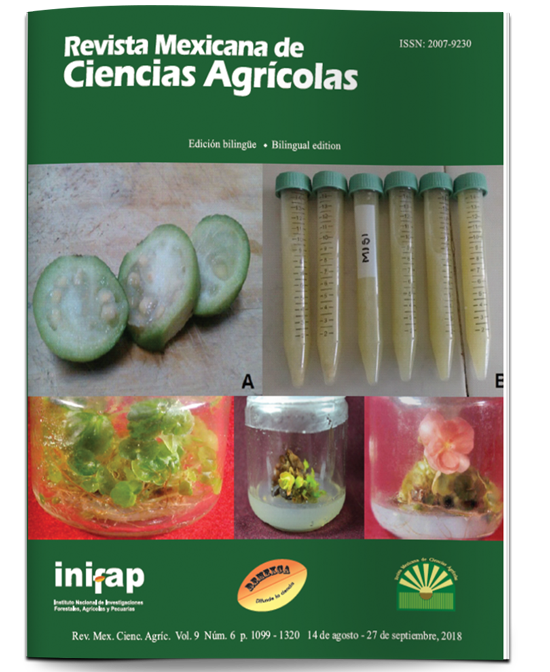Salinas: new variety of pinto beans for rainfed areas of Guanajuato
DOI:
https://doi.org/10.29312/remexca.v9i6.1589Keywords:
Phaseolus vulgaris L., resistance to diseases, slow darkening, undetermined habit-prostrateAbstract
Salinas is a variety of pinto beans, indeterminate-prostrate type III, short-day photoperiod, early maturity, rust-resistant, halo blight and anthracnose, slow darkening grain and high hydration capacity. It was developed by the Bajío Experimental Bean Program (CEBAJ). It was derived from the retro-cross of Pinto Saltillo// (Pinto Saltillo/97-RS-101) and its evaluation started as line F9 developed by pedigree selection. In later generations, it was evaluated based on yield and resistance to diseases in different places of the Semi-arid Highlands and Central Mexico. In three years of trial (2010-2012) in rainfed environments showed similar performance potential and was superior in disease resistance to Pinto Saltillo. Salinas carries molecular markers of genes associated with rust resistance (Ur3-Ur7, Ur9 and GB), anthracnose (Co1, Co12, Co2, Co4, Co42 and Co6) and halo blight (SR13, ST8, SAE15 and SW13) and in the field, shows resistance to the races of these prevalent diseases in Guanajuato. It is also resistant to common mosaic virus (BCMV) due to the presence of the gen I. Salinas gene produces medium-sized grain of mottled pinto type (33 ±3 g 100 seeds-1). The average yield in rainfed season depends on the environment and the agronomic management, in the localities of Guanajuato it goes from 622 kg ha-1 in San Luis of the Paz, to 3 209 kg ha-1in Salvatierra with optimal fertilization and sowing date.
Downloads
Downloads
Published
How to Cite
Issue
Section
License
The authors who publish in Revista Mexicana de Ciencias Agrícolas accept the following conditions:
In accordance with copyright laws, Revista Mexicana de Ciencias Agrícolas recognizes and respects the authors’ moral right and ownership of property rights which will be transferred to the journal for dissemination in open access. Invariably, all the authors have to sign a letter of transfer of property rights and of originality of the article to Instituto Nacional de Investigaciones Forestales, Agrícolas y Pecuarias (INIFAP) [National Institute of Forestry, Agricultural and Livestock Research]. The author(s) must pay a fee for the reception of articles before proceeding to editorial review.
All the texts published by Revista Mexicana de Ciencias Agrícolas —with no exception— are distributed under a Creative Commons License Attribution-NonCommercial 4.0 International (CC BY-NC 4.0), which allows third parties to use the publication as long as the work’s authorship and its first publication in this journal are mentioned.
The author(s) can enter into independent and additional contractual agreements for the nonexclusive distribution of the version of the article published in Revista Mexicana de Ciencias Agrícolas (for example include it into an institutional repository or publish it in a book) as long as it is clearly and explicitly indicated that the work was published for the first time in Revista Mexicana de Ciencias Agrícolas.
For all the above, the authors shall send the Letter-transfer of Property Rights for the first publication duly filled in and signed by the author(s). This form must be sent as a PDF file to: revista_atm@yahoo.com.mx; cienciasagricola@inifap.gob.mx; remexca2017@gmail.
This work is licensed under a Creative Commons Attribution-Noncommercial 4.0 International license.



